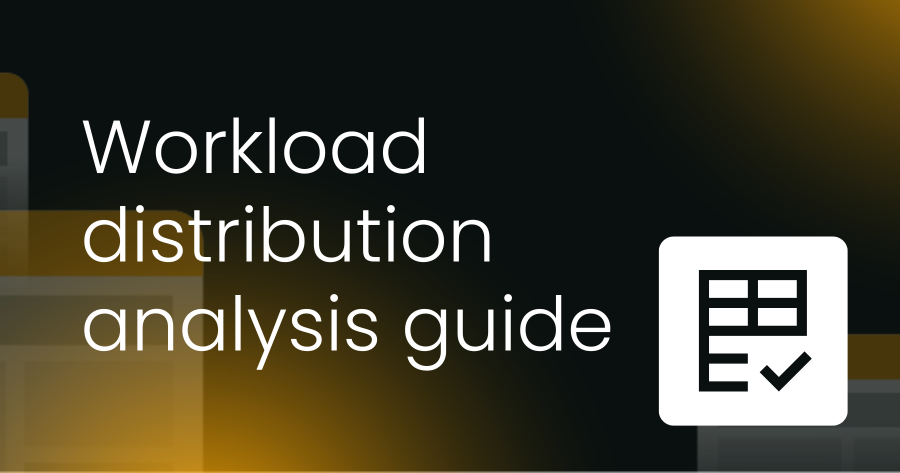Building a high-performing team isn't about luck, it's a deliberate process. But what truly separates a good team from a high performing one?
A good team gets the job done. But a team guided by high-end performance strategies consistently exceeds expectations, innovates under pressure, and drives sustainable growth.
If you want to transform your team into a high-performing one, you need to go beyond standard practices. This requires a new mindset that focuses on performance success strategies designed to unlock your team's full potential.
These aren't just a set of HR best practices, they’re a holistic approach to creating an elite, resilient, and highly motivated workforce. They focus on the human elements that truly drive success and, in this article, we’ll explore seven high-end performance strategies to help move your team from good to great.
7 high-end performance strategies
1. Align team goals with a shared vision
2. Optimize the team’s energy, not just their time
3. Build skills through targeted, deliberate practice
4. Strengthen psychological safety and emotional resilience
5. Make data-driven decisions and adapt quickly
6. Recognize and reward meaningfully
7. Shift from micromanagement to empowerment
1. Align team goals with a shared vision
The best teams aren't just busy, they're purpose driven. They know exactly where they're going and, more importantly, why their work matters.
When people understand how their daily efforts connect to a bigger purpose, they’re far more motivated to give their best. In fact, Gallup’s research found that employees who deeply connect their work to their company's mission are 4.6 times more likely to be engaged.
So, how do you make this happen?
Connect strategy to daily work
Don’t just share company-wide goals. Instead, show your team how their projects directly support them. For example, if the company’s mission is customer trust, a support team might focus on reducing resolution time as a way of building reliability.
Talk about impact, not just tasks
A goal like “deliver a solution that saves customers time and reduces frustration” feels a lot more meaningful than just “complete project X by September.” It gives the team a sense of purpose beyond a deadline.
Keep the vision in focus
It's easy for goals to get lost in the day-to-day chaos. Great leaders re-anchor the team by restating the purpose in meetings, retros, and one-on-one conversations, so everyone stays aligned.
Ultimately, a shared vision turns goals from a boring checklist into an incredible source of energy. It gives teams the resilience to tackle challenges and the drive to collaborate more effectively. That's the secret to consistent high performance and the foundation of all high-end performance strategies.

2. Optimize the team’s energy, not just their time
Most companies are obsessed with time management and things like calendars, deadlines, and productivity hacks. But what truly separates high-performing teams from the rest isn’t just how many hours they work, it’s how well they manage their energy.
If you want to put this into practice, try to:
- Protect focus time: Unnecessary meetings are a major energy drain. So, try to limit redundant meetings and encourage uninterrupted blocks of work.
- Build in recovery time: Encourage short breaks, offer flexible schedules, and remind people to step away from their desks, stretch, or even go for a quick walk.
- Track energy, not just output: A quick check-in or a simple pulse survey can help you understand how your team is really doing. By asking about energy levels, you can spot burnout before it happens and proactively adjust workloads to keep everyone running on full.
Time is a limited resource, but energy can be renewed and expanded. Teams that optimize for energy see higher creativity, better decision-making, and more sustainable performance over the long term. Instead of simply pushing harder, they're able to work smarter and keep going without burning out.
3. Build skills through deliberate practice
By focusing on small, targeted skill gains, your team builds confidence and adaptability, which are two essential ingredients for long-term growth. This approach is central to many high-end performance strategies in both business and even sports.
For HR and people leaders, this means moving beyond generic training and focusing on targeted, small-scale skill-building.
How to implement deliberate practice:
Offer micro-training. Instead of long, all-day workshops, provide short, focused sessions on critical skills like giving feedback or managing a project. This makes learning digestible and easy to apply immediately.
Encourage job shadowing. Let team members spend time in other departments to understand different roles. This not only builds empathy but also gives them a new perspective on how their work fits into the bigger picture.
Create real-time feedback loops. Don't wait for annual reviews. Use quick, informal check-ins and peer feedback to provide immediate, actionable coaching. This makes improvement a continuous process, not a one-time event.
4. Strengthen psychological safety and emotional resilience
No team can perform at its best if people are afraid to speak up, admit mistakes, or challenge ideas. Psychological safety (the belief that it’s safe to take risks, ask questions, and share concerns) is a critical foundation for collaboration. When employees feel safe, they’re more likely to contribute ideas, surface problems early, and support each other.
But safety is only half the equation. The other half is resilience, which is the ability to handle pressure and setbacks without burning out. In a world of constant change, resilient teams can take a hit, regroup, and adapt as a single unit instead of turning on each other.
As a leader, you have the power to create this environment. It starts with you. When you openly admit your own mistakes, actively listen, and respond to feedback constructively, you show that candor is a strength, not a weakness. This type of leadership sits at the core of proven performance success strategies for thriving in uncertainty.
Simple, daily practices can make a huge difference. End a meeting by sharing a key lesson learned from a misstep. Or, before jumping to solutions, make space to simply talk through a challenge and validate the team's frustrations. Over time, these small habits will build a culture of openness and strength that can withstand anything.

5. Make data-driven decisions and adapt quickly
Great teams don’t just rely on gut instinct, they let evidence guide their choices. Whether it’s performance metrics, customer feedback, or team surveys, data helps cut through assumptions and makes it clear where to focus.
The key is to make information practical. A team that regularly reviews the right signals can see what’s working, what’s not, and where small shifts could create big wins.
But data alone isn’t enough because high performers also move quickly on what they learn. They adjust priorities midstream, test new approaches, and aren’t afraid to let go of projects that no longer deliver value.
When leaders make decisions this way, they build trust and momentum. Teams know changes aren’t arbitrary, and they can see the reasoning behind them. Over time, this creates a culture of continuous improvement, where learning and adaptation become part of the rhythm of work. This combination of insight and agility is one of the defining traits of high-end performance strategies.
6. Recognize and reward meaningfully
Recognition is one of the simplest levers leaders have to boost performance - yet it’s often underused or done in ways that miss the mark. A generic “good job” rarely moves the needle. What really matters is recognition that feels genuine, timely, and connected to what the individual values.
Tips to make it work in practice:
- Be specific. Instead of “great work,” highlight exactly what stood out, such as: “the way you handled that client’s concern turned the meeting around.”
- Match the reward to the person. Some employees thrive on public praise, others value private acknowledgment or opportunities for growth.
- Celebrate progress, not just results. Recognizing effort and learning along the way reinforces good habits, not only final outcomes.
- Make it regular, not rare. A steady rhythm of recognition keeps motivation high while waiting for annual reviews makes it feel transactional.
- Link it to impact. Show how the contribution advanced team or company goals, so people see the bigger picture of their efforts.
When recognition is done well, it creates a culture where people feel valued and motivated to keep contributing at a high level. Rewards don’t always need to be monetary. Often, the most powerful motivator is simply feeling seen and appreciated.
7. Shift from micromanagement to empowerment
Micromanagement is one of the fastest ways to erode trust and stall performance. When leaders hover over every task, they signal a lack of confidence, and teams respond by playing it safe, waiting for instructions, and holding back their best ideas. Over time, creativity drops, motivation wanes, and the team becomes dependent instead of capable.
Empowerment flips that script. It means giving people clear direction, the resources they need, and then the autonomy to figure out the how. Instead of checking every detail, leaders shift their energy toward coaching, removing obstacles, and creating the space for ownership to grow.
In practice, empowerment might look like a manager setting clear outcomes for a project but leaving the team to decide the best path forward. It might mean encouraging experimentation, even if not every attempt succeeds. Or it could mean involving employees in decisions that affect their work, so they feel invested rather than dictated to.
Three ways to put empowerment into action include:
- Define the “what” and “why,” but leave room for the “how.” Give teams clarity on goals and purpose, while trusting them to choose the best approach.
- Provide guardrails, not roadmaps. Share expectations, resources, and deadlines, but avoid prescribing every step.
- Shift your role to coach. Ask questions that spark thinking, give feedback that stretches skills, and step in only when needed.
When people feel trusted, they step up. They take more initiative, collaborate more freely, and push themselves to find better solutions.
Empowerment doesn’t just lighten a manager’s workload, it’s one of the most impactful high-end performance strategies for building long-term capability.
Become an Insider member
If you’re ready to take your HR strategies to the next level, why not join the thousands of HR and people professionals who trust People Alliance as their go-to resource?
With a free Insider membership, you’ll get:
- Expert insights – battle-tested templates and frameworks for your biggest HR challenges
- Ready-to-use tools – solve problems faster with the collective know-how of our community
- Peer connections – exchange ideas with people leaders around the globe
- Real-world cases – hours of insights from Fortune 500 companies and exciting startups
- Exclusive content – in-depth guides and articles from world-class people teams
- Industry events – free access to expert-led events and networking opportunities
As an Insider, you’re not just signing up - you’re stepping into a community where expertise meets innovation. Your next career breakthrough starts here.



 Follow us on LinkedIn
Follow us on LinkedIn


